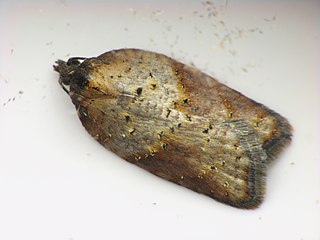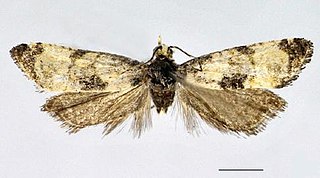
Notocelia rosaecolana is a moth of the family Tortricidae. It is found in the Palearctic realm, where it has been recorded from China, Mongolia, Korea, Japan, Iran, Central Asia, Russia and Europe.

Epinotia ramella is a moth of the family Tortricidae. It is found in Europe, China, Japan, Russia and Kazakhstan.
Paratorna is a genus of moths belonging to the subfamily Tortricinae of the family Tortricidae. The genus was erected by Edward Meyrick in 1907.

The Tortricini are a tribe of tortrix moths.

Cochylichroa atricapitana, the black-headed conch, is a moth of the family Tortricidae. It is found in China (Xinjiang) and the eastern Palearctic and most of Europe.

Cochylis dubitana, the little conch, is a moth of the family Tortricidae. It is found in China (Heilongjiang) and most of Europe. and the Caucasus. It is also found in North America, where it has been recorded from Colorado, Maine, Ontario and Washington.
Sparganothina neoamoebaea is a species of moth of the family Tortricidae. It is found in Jalisco, Mexico.
Sparganothina amoebaea is a species of moth of the family Tortricidae. It is found in Guerrero, Mexico.
Orthocomotis lactistrigata is a species of moth of the family Tortricidae. It is found in Carchi Province, Ecuador.

Cnephasia longana, the omnivorous leaftier moth, long-winged shade or strawberry fruitworm, is a moth of the family Tortricidae. It was described by Adrian Hardy Haworth in 1811. It is native to western Europe. It is an introduced species in western North America. The species has also been reported from north-western Africa and Asia. The habitat consists of downland and rough ground.
Saphenista runtuna is a species of moth of the family Tortricidae. It is found in Tungurahua Province, Ecuador.
Archips tharsaleopus is a species of moth of the family Tortricidae. It is found in Zhejiang and Yunnan, China.
Archips kellerianus is a species of moth of the family Tortricidae. It is found in Yunnan and Sichuan, China.
Archips opiparus is a species of moth of the family Tortricidae. It is found in the Chinese provinces of Guizhou, Hunan, Sichuan and Yunnan.
Meridemis validana is a species of moth of the family Tortricidae. It is found in Vietnam.
Atriscripta arithmetica is a species of moth of the family Tortricidae. It is found in New Caledonia and Australia, where it has been recorded from Queensland. The habitat consists of rainforests, as well as planted forests.
Acleris caerulescens is a species of moth of the family Tortricidae. It is found in the Russian Far East (Ussuri), eastern China and Japan.
Paratorna schintlmeisteri is a species of moth of the family Tortricidae. It is found in the Philippines (Luzon).
Grapholita schizodelta is a moth of the family Tortricidae first described by Alexey Diakonoff in 1982. It is found in Sri Lanka.
Ancylis stenampyx is a moth of the family Tortricidae first described by Alexey Diakonoff in 1982. It is found in Sri Lanka.





